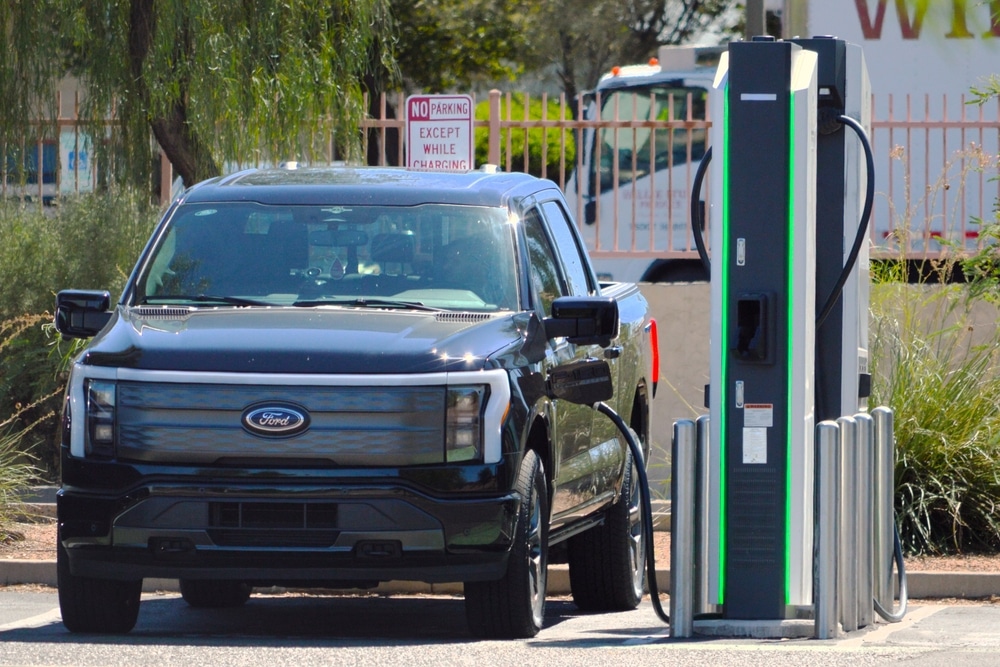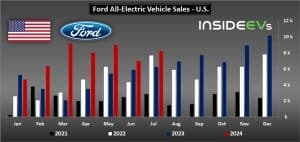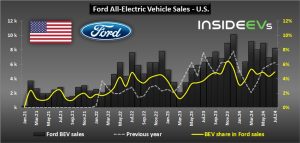Ford Motor Company has announced a significant shift in its electric vehicle strategy, affecting its production plans and financial outlook. The automaker is delaying the launch of a next-generation all-electric pickup truck and scrapping the development of a new three-row electric SUV. Instead, Ford will focus on enhancing its hybrid lineup and expanding its range of commercial electric vehicles (EVs).
Ford Steers Towards Hybrids and Commercial EVs
Ford’s EV sales saw significant growth in July, with a 31% increase compared to the same month last year. This boost was driven by strong performances from the Mustang Mach-E and F-150 Lightning, despite overall vehicle sales experiencing slower growth.
- READ MORE: Ford’s EV Sales in U.S. Surge by Over 200%
Ford’s SUV sales have been a significant drag on its overall performance, with a 7% decline in July. Key models like the Edge (-59%), Bronco (-30%), and Escape (-15%) saw double-digit drops. The company ended production of the Edge earlier this year, while the new Explorer managed to boost sales by 49% last month.
During Ford’s Q2 earnings call, CEO Jim Farley emphasized the company’s shift towards developing smaller, more affordable EVs. The team in Long Beach, composed of former executives from Tesla, Rivian, Lucid, and Apple, is focused on creating highly efficient electric vehicles.
Farley highlighted that Tesla and low-cost Chinese OEMs represent the primary competition. He further anticipates many rivals will seek EV platforms from China, similar to Volkswagen’s strategy. Most recently, the US automaker unveiled its changing EV plans.
The next-generation electric pickup trucks, originally scheduled for production at Ford’s new $5.6 billion plant in Tennessee, will now debut later than planned. The full-size truck will be produced in 2027, while a new midsize truck is being developed in California.
The shift in focus aims to leverage Ford’s strengths in commercial vehicles and SUVs, according to CFO John Lawler.
Ford’s Revamped EV Roadmap and Strategic Shift
The decision to pivot comes as Ford responds to market trends and customer preferences. Lawler emphasized the company’s commitment to aligning with areas where it has a competitive advantage, like commercial trucks and SUVs. This strategy adjustment is expected to result in a special noncash charge of about $400 million for the write-down of certain assets, including the canceled SUV.
Ford’s future capital expenditure plans will shift focus from investing around 40% of its budget into all-electric vehicles to about 30%. Although a specific timeline for this change was not provided, it reflects the company’s recalibrated approach to EV investments. Production at the Tennessee plant, initially set to begin next year, will now see battery cell production starting in 2025.
The adjustments come amid slower-than-expected adoption of EVs and challenges in achieving profitability with these vehicles. Ford’s new strategy follows a previous decision to delay production of the three-row SUV and the next-generation electric pickup, codenamed “T3.”
Lawler stated that the company’s agility in responding to customer feedback is crucial, highlighting the need for more diverse electrification options based on market experience over the past two years.
From All-Electric Ambitions to Hybrid Reality
Ford will continue to produce and enhance existing electric models, including the Mustang Mach-E and F-150 Lightning. The company plans to introduce its next generation of EVs with a new commercial van to be assembled at Ford’s Ohio Assembly Plant in 2026.
It will be followed by two new pickup trucks in 2027: a medium-size truck developed by Ford’s California Skunkworks team and the Project T3 truck.
Ford has also announced plans to enhance its battery production capabilities. Starting in 2025, battery production for the Mustang Mach-E will shift from Poland to a new plant in Holland, Michigan. This is to qualify the production for Inflation Reduction Act (IRA) tax credits.
The BlueOval SK Kentucky plant will produce cells for the current E-Transit commercial van. The BlueOval City plant in Tennessee will manufacture cells for the new electric commercial van and the Project T3 truck in 2025.
Additionally, Ford is set to begin lithium iron phosphate (LFP) battery production in 2026 at BlueOval Battery Park Michigan. The carmaker will use technology licensed from China’s CATL. This plant will also benefit from IRA incentives.
The company’s revised approach aligns with its previously announced $12 billion reduction in EV spending. Ford will seek to comply with emissions targets through various means, including purchasing regulatory carbon credits as needed. Tesla, by far, is the largest seller of these carbon credits to its peers failing to meet emissions regulations.
This strategic pivot aligns with Ford’s revised approach to EV profitability, moving away from initially selling EVs at a loss to meet regulatory standards and grow market share. Ford has pledged to provide a detailed update on its electrification strategy, technology advancements, profitability, and capital needs in the first half of 2025 during its “EV Day”.




